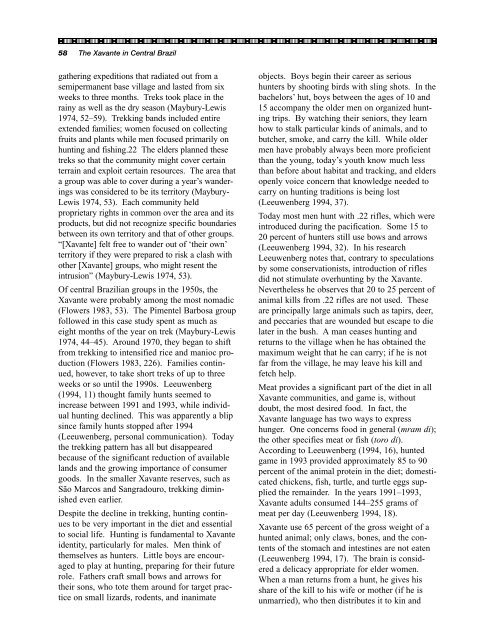Indigenous Peoples and Conservation Organizations
Indigenous Peoples and Conservation Organizations
Indigenous Peoples and Conservation Organizations
Create successful ePaper yourself
Turn your PDF publications into a flip-book with our unique Google optimized e-Paper software.
58 The Xavante in Central Brazil<br />
gathering expeditions that radiated out from a<br />
semipermanent base village <strong>and</strong> lasted from six<br />
weeks to three months. Treks took place in the<br />
rainy as well as the dry season (Maybury-Lewis<br />
1974, 52–59). Trekking b<strong>and</strong>s included entire<br />
extended families; women focused on collecting<br />
fruits <strong>and</strong> plants while men focused primarily on<br />
hunting <strong>and</strong> fishing.22 The elders planned these<br />
treks so that the community might cover certain<br />
terrain <strong>and</strong> exploit certain resources. The area that<br />
a group was able to cover during a year’s w<strong>and</strong>erings<br />
was considered to be its territory (Maybury-<br />
Lewis 1974, 53). Each community held<br />
proprietary rights in common over the area <strong>and</strong> its<br />
products, but did not recognize specific boundaries<br />
between its own territory <strong>and</strong> that of other groups.<br />
“[Xavante] felt free to w<strong>and</strong>er out of ‘their own’<br />
territory if they were prepared to risk a clash with<br />
other [Xavante] groups, who might resent the<br />
intrusion” (Maybury-Lewis 1974, 53).<br />
Of central Brazilian groups in the 1950s, the<br />
Xavante were probably among the most nomadic<br />
(Flowers 1983, 53). The Pimentel Barbosa group<br />
followed in this case study spent as much as<br />
eight months of the year on trek (Maybury-Lewis<br />
1974, 44–45). Around 1970, they began to shift<br />
from trekking to intensified rice <strong>and</strong> manioc production<br />
(Flowers 1983, 226). Families continued,<br />
however, to take short treks of up to three<br />
weeks or so until the 1990s. Leeuwenberg<br />
(1994, 11) thought family hunts seemed to<br />
increase between 1991 <strong>and</strong> 1993, while individual<br />
hunting declined. This was apparently a blip<br />
since family hunts stopped after 1994<br />
(Leeuwenberg, personal communication). Today<br />
the trekking pattern has all but disappeared<br />
because of the significant reduction of available<br />
l<strong>and</strong>s <strong>and</strong> the growing importance of consumer<br />
goods. In the smaller Xavante reserves, such as<br />
São Marcos <strong>and</strong> Sangradouro, trekking diminished<br />
even earlier.<br />
Despite the decline in trekking, hunting continues<br />
to be very important in the diet <strong>and</strong> essential<br />
to social life. Hunting is fundamental to Xavante<br />
identity, particularly for males. Men think of<br />
themselves as hunters. Little boys are encouraged<br />
to play at hunting, preparing for their future<br />
role. Fathers craft small bows <strong>and</strong> arrows for<br />
their sons, who tote them around for target practice<br />
on small lizards, rodents, <strong>and</strong> inanimate<br />
objects. Boys begin their career as serious<br />
hunters by shooting birds with sling shots. In the<br />
bachelors’ hut, boys between the ages of 10 <strong>and</strong><br />
15 accompany the older men on organized hunting<br />
trips. By watching their seniors, they learn<br />
how to stalk particular kinds of animals, <strong>and</strong> to<br />
butcher, smoke, <strong>and</strong> carry the kill. While older<br />
men have probably always been more proficient<br />
than the young, today’s youth know much less<br />
than before about habitat <strong>and</strong> tracking, <strong>and</strong> elders<br />
openly voice concern that knowledge needed to<br />
carry on hunting traditions is being lost<br />
(Leeuwenberg 1994, 37).<br />
Today most men hunt with .22 rifles, which were<br />
introduced during the pacification. Some 15 to<br />
20 percent of hunters still use bows <strong>and</strong> arrows<br />
(Leeuwenberg 1994, 32). In his research<br />
Leeuwenberg notes that, contrary to speculations<br />
by some conservationists, introduction of rifles<br />
did not stimulate overhunting by the Xavante.<br />
Nevertheless he observes that 20 to 25 percent of<br />
animal kills from .22 rifles are not used. These<br />
are principally large animals such as tapirs, deer,<br />
<strong>and</strong> peccaries that are wounded but escape to die<br />
later in the bush. A man ceases hunting <strong>and</strong><br />
returns to the village when he has obtained the<br />
maximum weight that he can carry; if he is not<br />
far from the village, he may leave his kill <strong>and</strong><br />
fetch help.<br />
Meat provides a significant part of the diet in all<br />
Xavante communities, <strong>and</strong> game is, without<br />
doubt, the most desired food. In fact, the<br />
Xavante language has two ways to express<br />
hunger. One concerns food in general (mram di);<br />
the other specifies meat or fish (toro di).<br />
According to Leeuwenberg (1994, 16), hunted<br />
game in 1993 provided approximately 85 to 90<br />
percent of the animal protein in the diet; domesticated<br />
chickens, fish, turtle, <strong>and</strong> turtle eggs supplied<br />
the remainder. In the years 1991–1993,<br />
Xavante adults consumed 144–255 grams of<br />
meat per day (Leeuwenberg 1994, 18).<br />
Xavante use 65 percent of the gross weight of a<br />
hunted animal; only claws, bones, <strong>and</strong> the contents<br />
of the stomach <strong>and</strong> intestines are not eaten<br />
(Leeuwenberg 1994, 17). The brain is considered<br />
a delicacy appropriate for elder women.<br />
When a man returns from a hunt, he gives his<br />
share of the kill to his wife or mother (if he is<br />
unmarried), who then distributes it to kin <strong>and</strong>

















